What is the best kitchen flooring? 9 materials for a hardworking but stylish space
Experts explain the best kitchen flooring choices to make, ensuring your pick is durable and looks good too
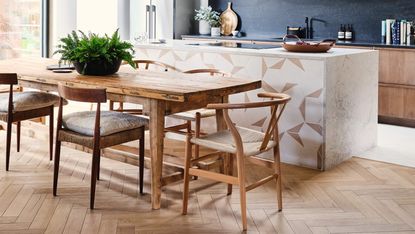

The best kitchen flooring is a combination of many things. It is hardwearing, taking the toll of daily use and spillages in a busy space. It is long-lasting, investing in the right material will last your kitchen a lifetime. Lastly, it is aesthetically beautiful, taking center stage in your home.
Whether you're into the look and feel of natural stone, cold on your feet and giving a rustic, countryside look, or you're partial to the Herringbone wooden floor synonymous with a Parisian apartment, these are the kitchen flooring ideas that can raise your interiors game.
What is the best kitchen flooring?
The best kitchen flooring is all about your personal style and what you want from a space. Consider who uses it, how many people are in the home and whether your kitchen is a busy room, and cost when deciding on the kitchen flooring solution for you. When it comes to what is the best, tiles, natural stones and woods can be a great addition.
'Kitchen floors need to be robust and easy to clean – particularly in today's busy homes, and with more of us having pets – so hardwearing porcelain tiles are an ideal choice.' explains Colin Roby-Welford, Fired Earth's creative director.
Elsewhere, terracotta, hardwood and different types of natural stone win points for their combination of durability and style. Here's our run drundownown of the best kitchen flooring materials out there and how to look after them.
1. Terracotta tiles
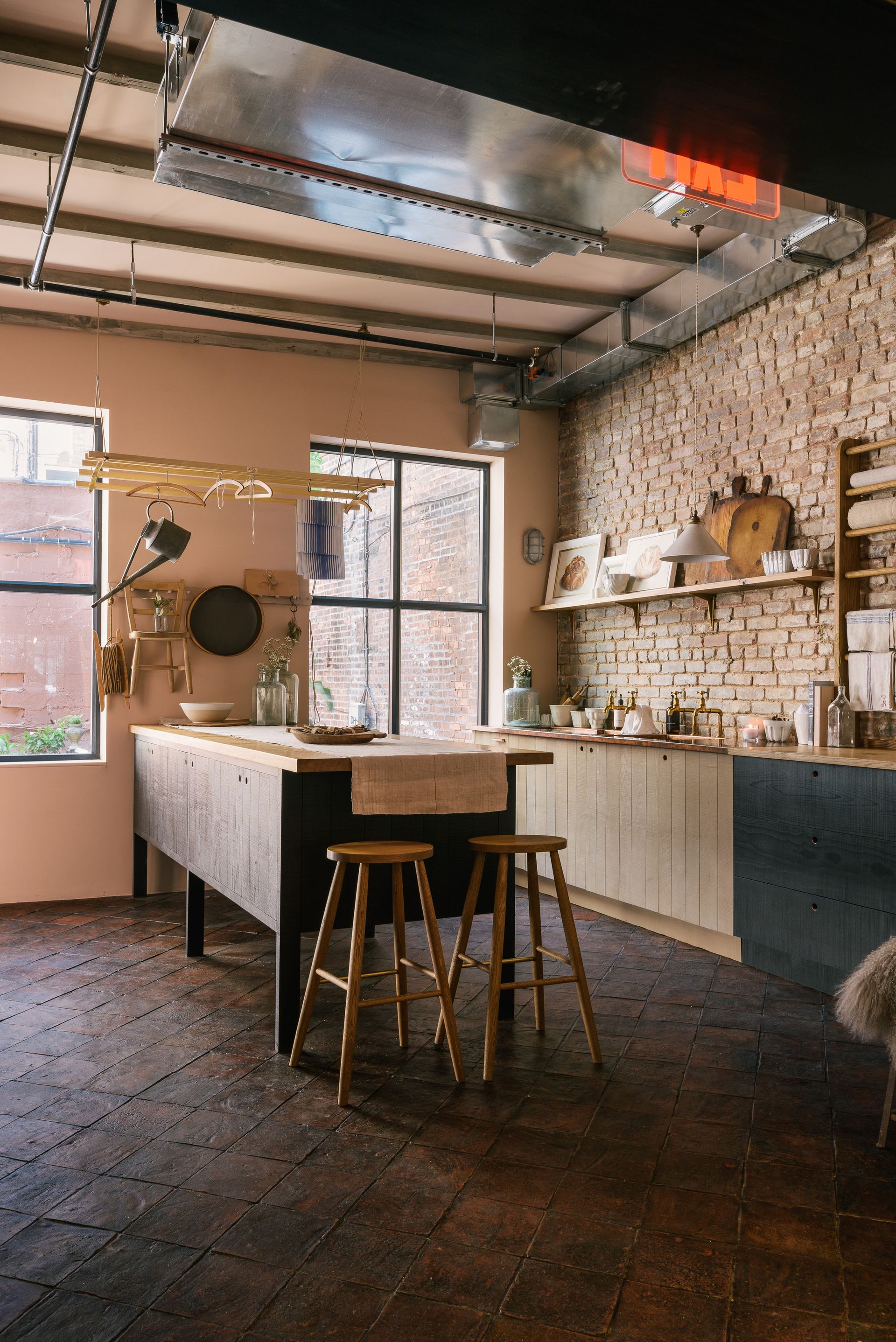
A terracotta kitchen floor can give a real earthy and rustic look, while bringing warmth to the scheme, making for an excellent kitchen floor tile idea.
Terracotta is made from clay, which has a very high iron content which is why they give off that deep red hue. 'Terracotta works perfectly in a kitchen if you are looking to reinstate original features and character into a property,' says Molly, flooring expert at Floors of Stone, who created the above terracotta tiles for Sebastian Cox. 'They often get mistaken for original floor tiles that have been laid for centuries!'
There are a lot of factors to bear in mind when installing terracotta tiles, so always check with an installer, but the main thing to remember is to treat the terracotta tiles with boiled linseed oil as well as either a clear or antiqued beeswax.
'As long as the correct treatment is applied to terracotta tiles during installation, they are easy to maintain,' explains Molly. 'They will need to be re-waxed over time but we sell a Waxwash product which helps to top up the boiled linseed oil as you clean the floor and therefore eases the maintenance of the tiles.'
2. Vinyl
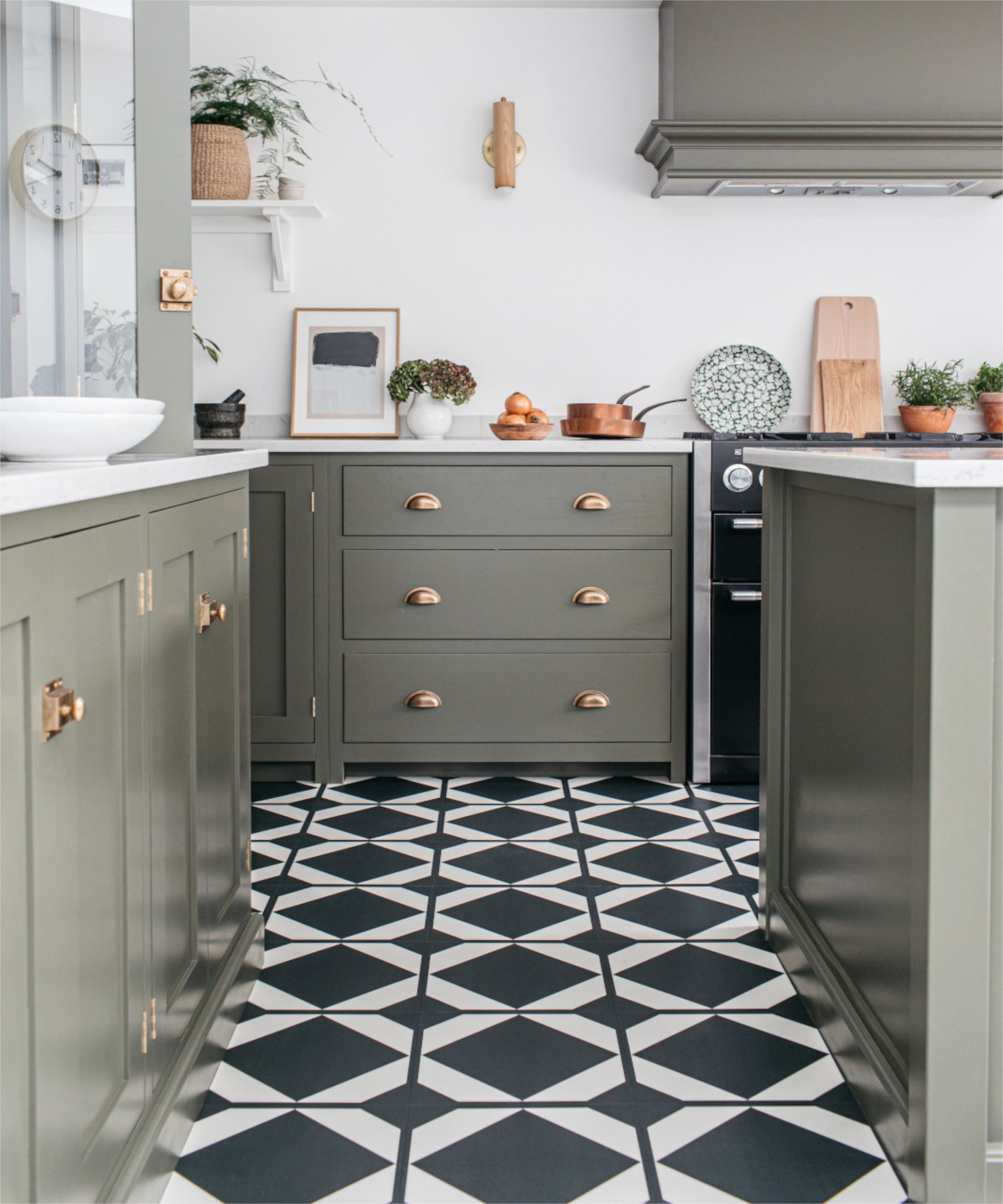
Vinyl kitchen flooring is a great idea for this homely space. Not only is vinyl resilient and waterproof, it is known for its durability, stain and water-resistance and ability to maintain. It's super easy to install too, and is a great option if you're going DIY.
It's been a popular option for kitchens for a while, meaning that technology has advanced and you can get a real wide array of patterns, like this charming monochrome look that gives real wow factor to your kitchen.
3. Hardwood flooring
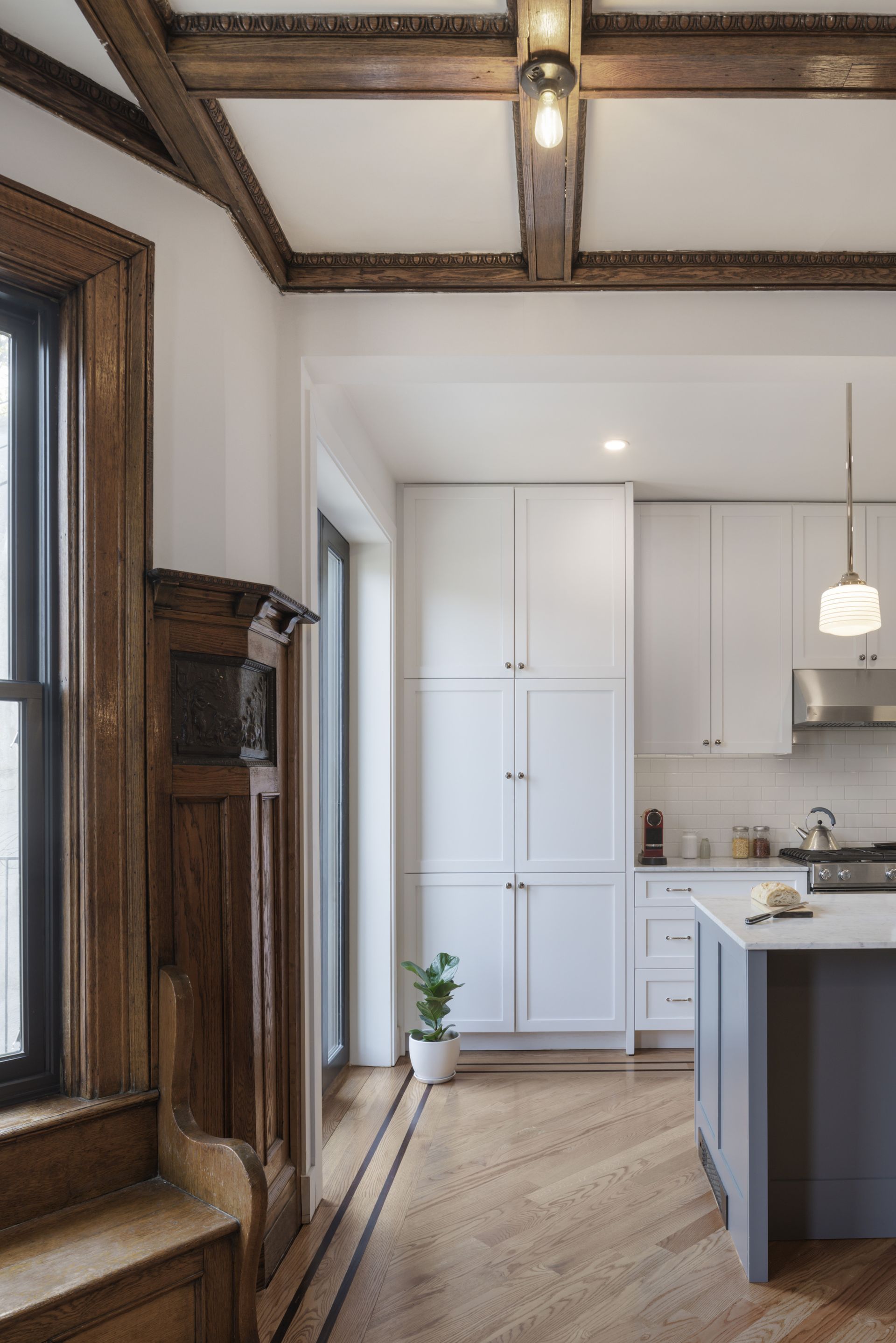
Hardwood flooring is an excellent option for your kitchen floor. It gives a luxurious and timeless finish, while also being durable, warm, stylish and water-resistant, although not waterproof and should be maintained with a proper finish to avoid moisture damage.
Within wood kitchen flooring ideas, there are so many ways that make your wood floor different from another. Think about the lightness of finish, lay patterns for the tiles, from Herringbone to diagonal, to wide plank. Trend-wise, reclaimed, recycled and environmentally sustainable choices are popular for hardwood flooring.
The above example from Studio Officina Architecture PLLC is a design in a Brooklyn townhouse where a narrow board red oak floor matches the paneling in the home to give a traditional look.
'We ran the wood flooring into the kitchen so that the open plan and dining room and kitchen area would all feel unified. We installed the new boards on the diagonal as a fresh and budget-conscious take on the historic Herringbone and parquet floors you often see in these old Brooklyn houses.'
'I think it evokes a mood of warmth that is reminiscent of the history of the house without clinging too closely to the traditional details.'
Katie Hudghton, head of marketing at Ted Todd says 'We’re seeing a huge push for white and light coloured wood flooring at the moment and is a trend that is set to stay through until next year. In particular our Warehouse and Project collections have been popular.
'Lighter flooring allows light to bounce around a room, which can make rooms feel bigger and brighter.'
4. Concrete
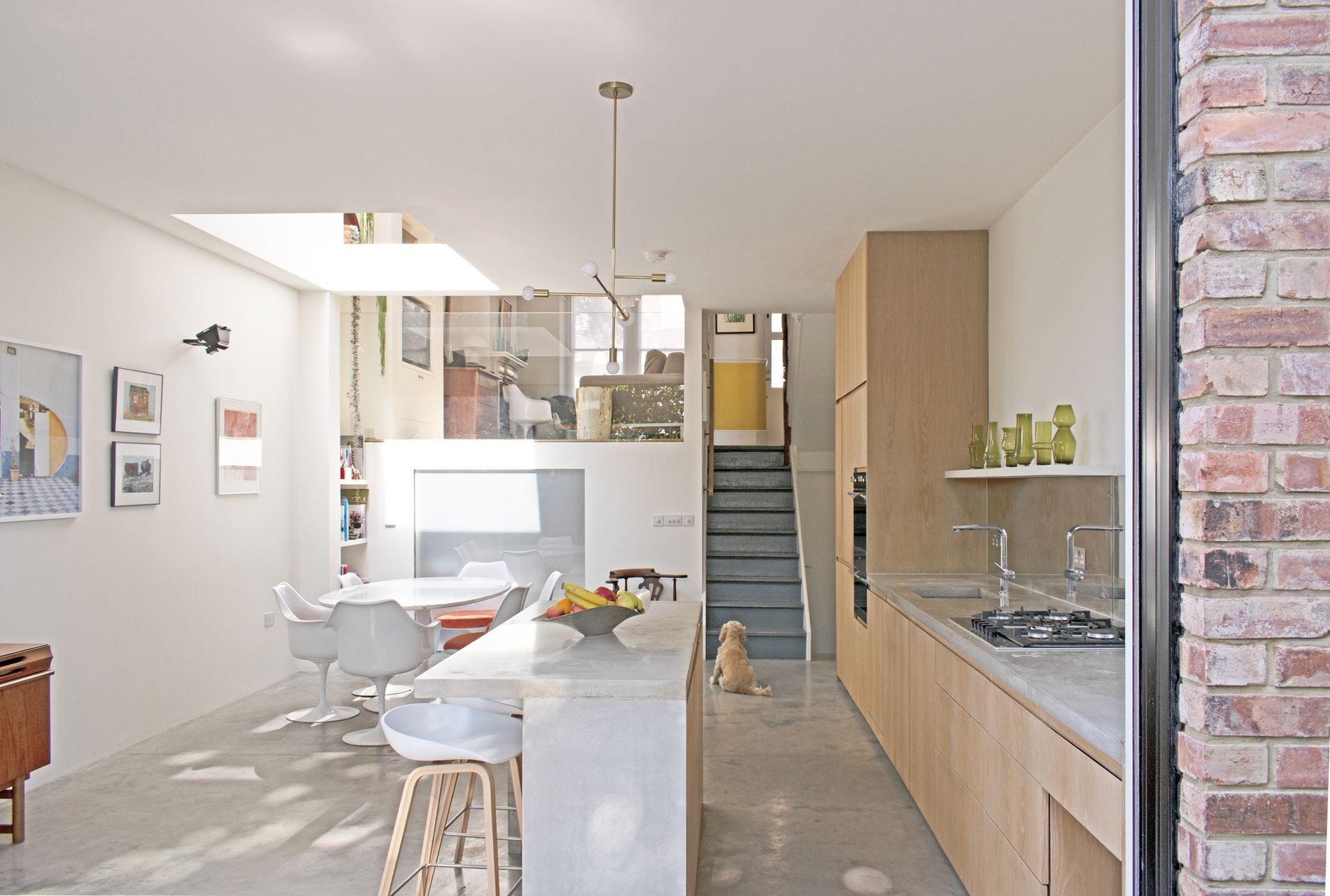
For an industrial and modern look in the kitchen, the trend for concrete, is a hard-wearing, easy-to-clean flooring option that is gaining popularity for its chic finish. The flooring is made from either raw or colored concrete which has been sealed for a non-porous surface.
Polished concrete is hardwearing which makes it a perfect match for a kitchen. You can install large surfaces without joint lines, which makes them more appealing to the view but also easier to clean. You do still need to take care of it, as it can stain if you leave uncleaned spillages for a very long time, but it is very robust.
This polished concrete floor was designed by William Tozer Associates, and helps to give a feeling of the outdoors, in. 'Along with the full-height and full-width sliding doors, and the flush threshold, the continuity of the concrete floor from inside to out makes the kitchen and dining space feel like part of the exterior space, and vice versa,' explains Adoracion Marco Vidal.
'We are really interested in capturing the open-ended quality of building sites in our completed projects, and polished concrete is one of the raw materials that we use to make people feel engaged with the construction process in the finished building. Due to the nature of the product, you get variations in tone and color, as you would with a natural stone.'
Due to its mass, concrete also works very well when combined with underfloor heating, retaining and reradiating heat for a very long time. But you've got to be careful with it. 'Concrete doesn't like a sudden temperature change,' adds Celine Erlam of Indie & Co, 'so you are better off turning the heating on slowly or it will crack.'
5. Engineered wood
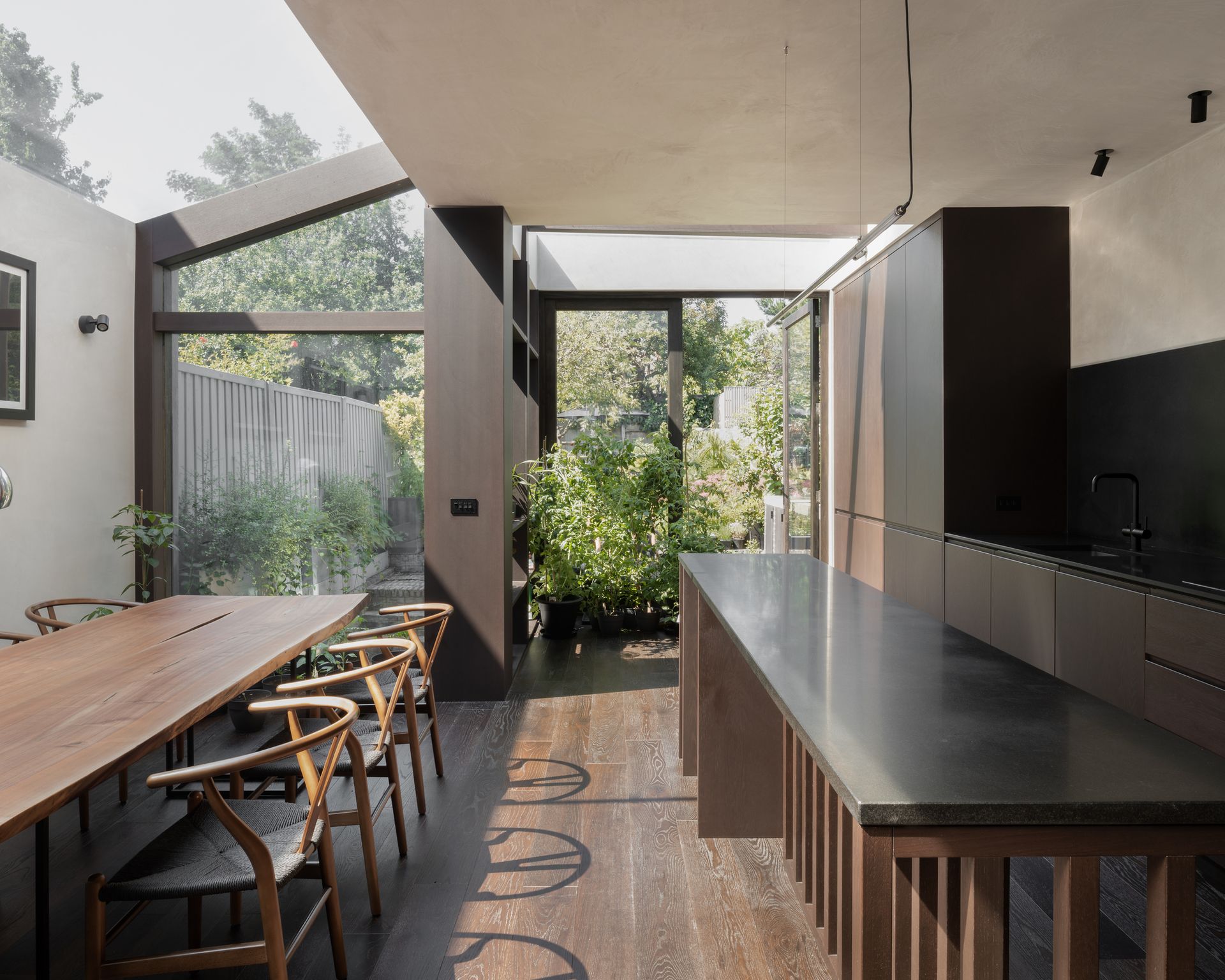
For an inexpensive floor that gives the wooden effect, try engineered wood flooring - made from a mixture of materials like wood fibres, sawdust and chemicals. A top layer of real wood is then stuck to the top.
This floor uses Ted Todd Engineered wood plank liquorice. The flooring is good because of its sustainability credential, while it provides good performance in extra wear and splash resistance.
'Engineered wood flooring tends to be more stable, in the sense of sensitivity to the changes in humidity and temperature, therefore a good choice for wet areas like a kitchen. Usually, the oil-based finish has an outer layer that is hardened to give extra wear and splash resistance. Additionally, this also allows easy maintenance while offering a great range of colour and texture selection to match with the interior.' says Thomas Barstow of Unagru, who designed this space.
6. Ceramic tiles
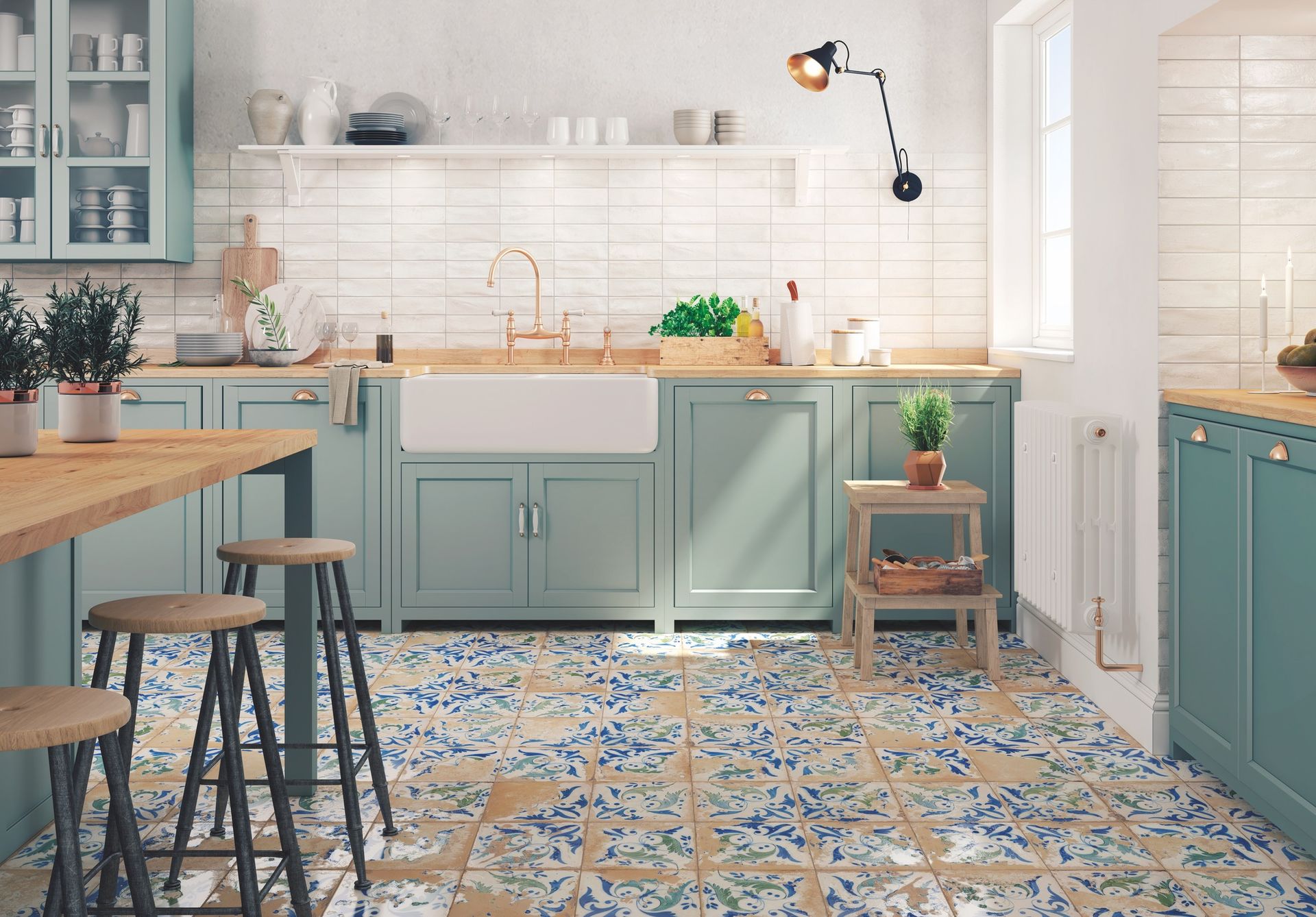
A ceramic tiled floor is another good option for your kitchen. The tile is a classic choice that looks elegant, sophisticated, and is quick to clean. There is a huge versatility out there in the world of tiles, with technology meaning you can get a natural stone or wood effect printed on your tile, or an aesthetically pleasing pattern, so you'll be able to find a style that suits your kitchen floor. You'll need to know how to choose a floor color, of course.
Ceramic tiles are great as they stand up to the wear and tear of a bustling kitchen, from footprints to spillages and spills. Ceramic is an easy-to-clean option, and it is also affordable - with a huge variety of low-priced options out there.
A drawback of which to be mindful when planning your ceramic kitchen floor is that the tile can crack and it can be cold and hard underfoot. If you want to soften the space, use a rug - this will warm it up and give the space more traction.
7. Stone
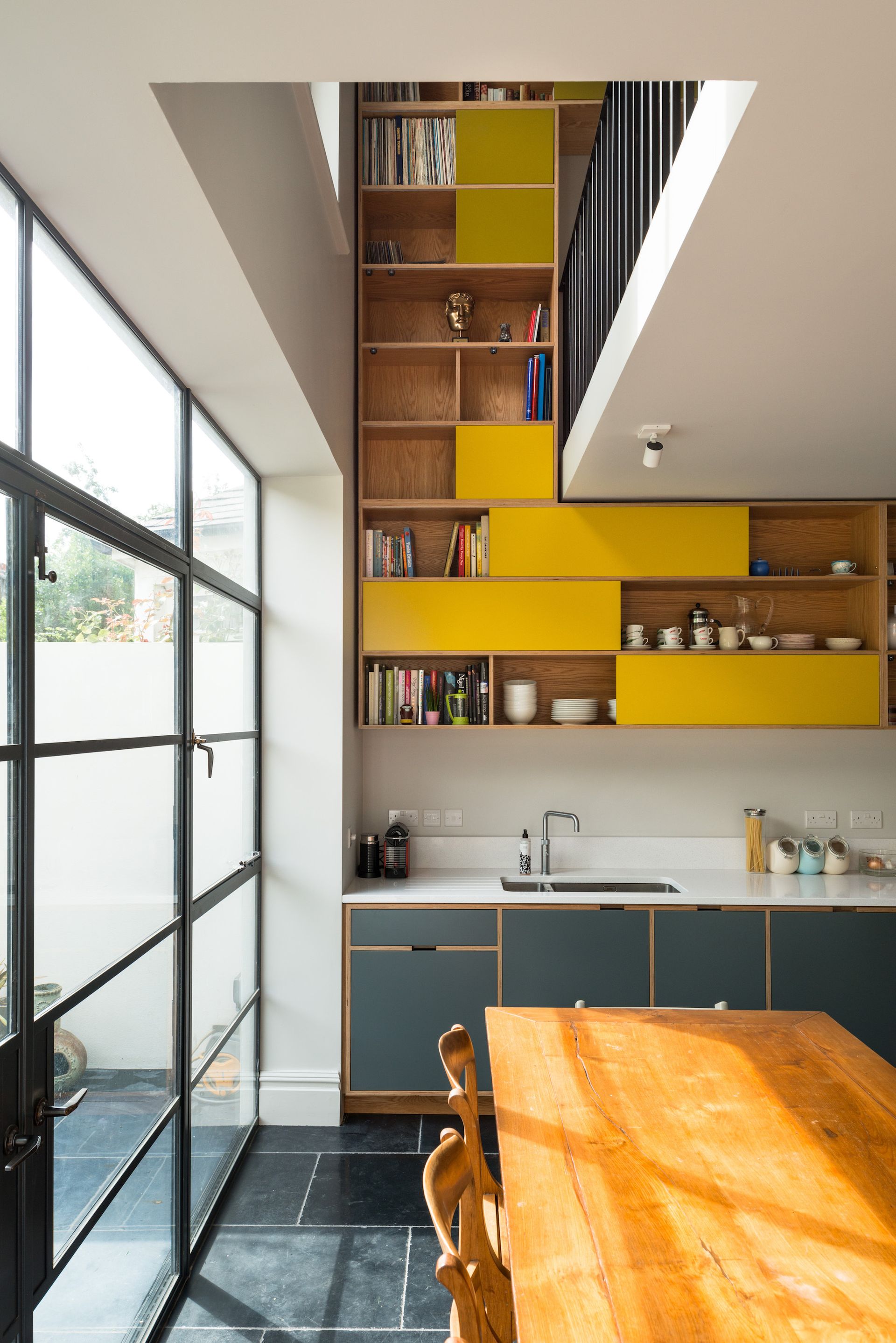
For a rustic kitchen look that helps you recreate a bit of a farmhouse kitchen vibe, and if you're wanting to go for a stone flooring look, limestone is a great option. It can look modern and traditional all at once, and is sleek yet excellent for the durability factor. In this split section home, designed by MW Architects, the designer has enlisted the help of limestone from Fired Earth, specifically the Carnforth Leighton floor, to tie the scheme together.
'Aesthetically, the client wanted a dark stone floor but one that had durability and more beauty than just slate,' explains Melissa Robinson of MW Architects. 'This is what this limestone did. It was run to the base of the house kitchen and down to the basement to ground everything.'
'Limestone is quite a traditional type of floor for a Victorian house in the kitchen and working parts and so it worked well to enhance the existing traditional feel generally that had been maintained as well as complimenting the new addition of the more modern kitchen design.'
8. Porcelain
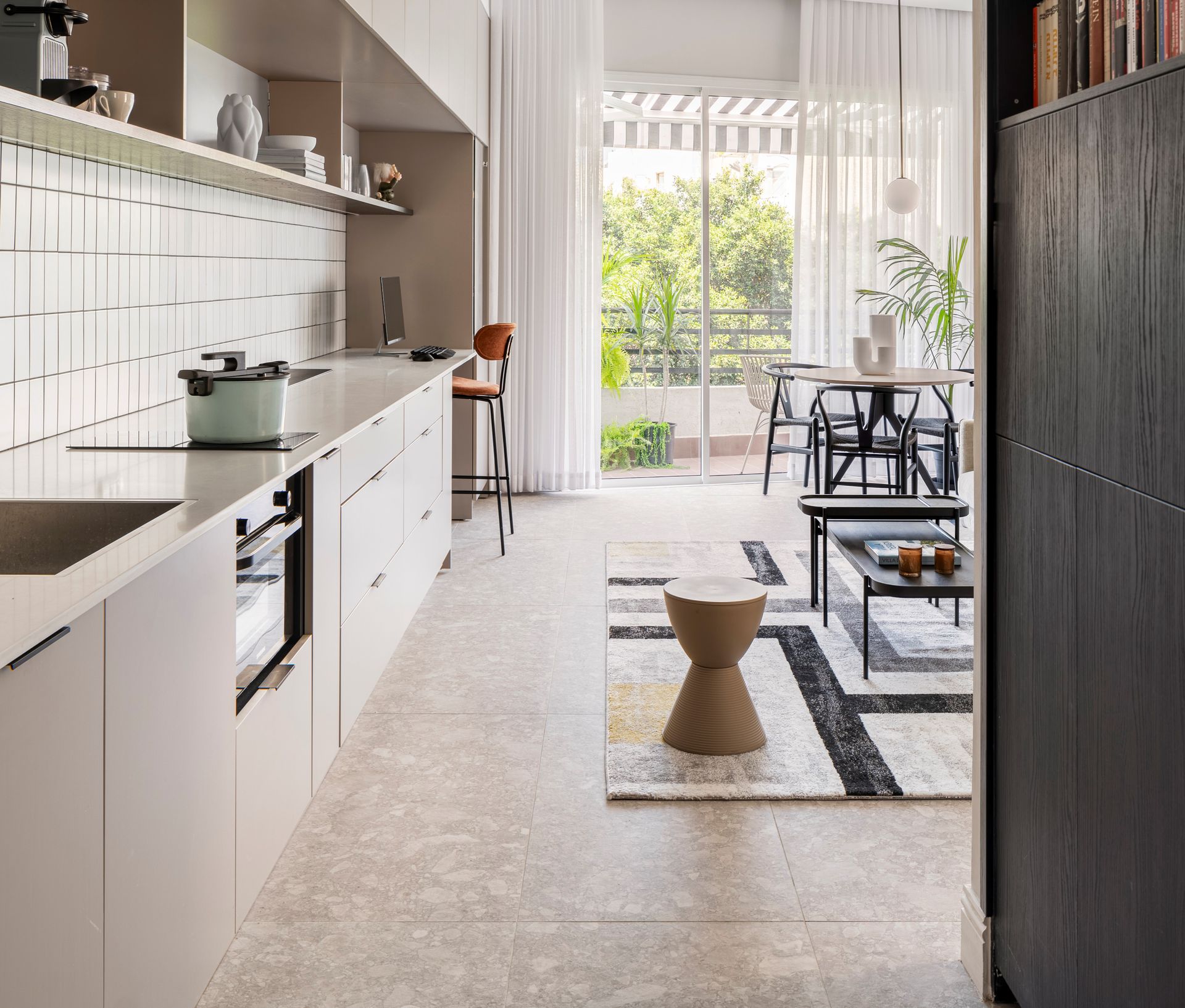
Hardwearing, reliable, durable and versatile and easy to clean, porcelain is a great option for the floor of your kitchen, and often wins in the ceramic vs porcelain debate. 'Porcelain is undoubtedly the most practical floor option for kitchens, designed to be stain and water-resistant, once laid it will simply need a hoover and a mop,' says Rob Whitaker, creative and product director of Claybrook.
'As many of us opt for spaces that take in both a kitchen and dining zone in one, the floor area requiring coverage has increased in the last two decades. Larger format porcelain (think 80cm x 80cm and above), is ideal for drawing the eye across the floor, making the area feel attractively open.'
Porcelain with a tumbling effect is a trending look for flooring, giving off the effect of limestone with a rustic, rough edge.
In this example, k.o.t architects have opted for a kitchen floor made up of rectangular porcelain tiles in the appearance of terrazzo and rock fragments. The tile has a matte grey finish.
'The appearance of the tile corresponds with the original tile that was in the apartment when the building was built in the late 1920s and early 1930s in Tel Aviv as part of the international and Bauhaus style of that time. The grey shade serves as a bright and pleasant background for the fixed and mobile furniture.'
The tile is a porcelain granite tile with an abrasion grade suitable for wet spaces, it has a matte finish and is very resistant to liquids and oils of any kind.
9. Marble
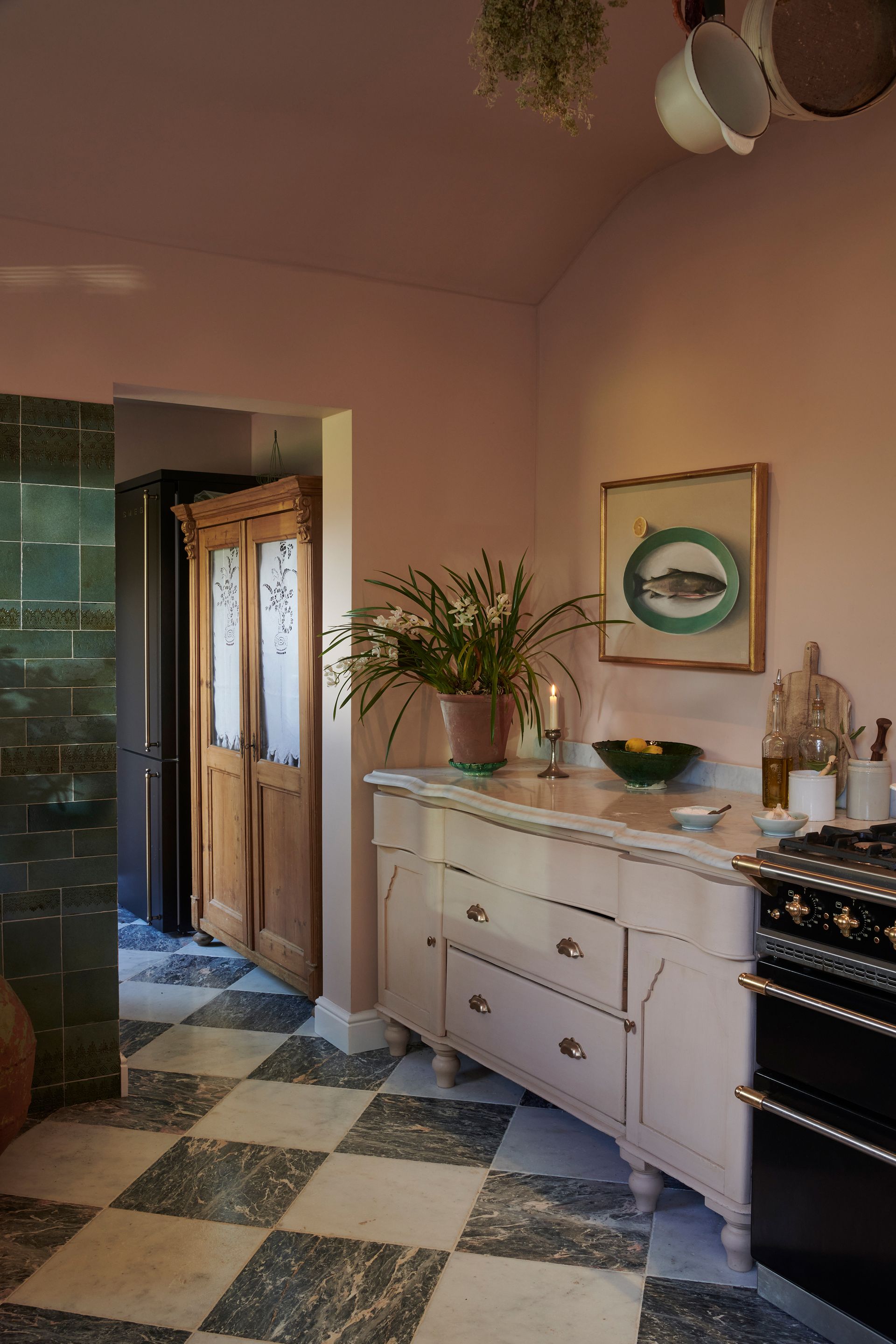
As far as natural stone goes, a marble kitchen is the ultimate interiors dream for most homeowners. It is durable, beautiful and has an incredible quality, explains Molly Platts, of Floors of Stone who created the marble flooring for the above deVOL kitchen.
'Marble is a beautiful material to go for in a kitchen space as there are so many beautiful details you find in marble tiles that you don't always get in other natural materials, such as strong veins and stunning quartz detailing.'
Marble tiles do need to be sealed, as do all other natural stones, and by sealing them it helps to prevent the tiles from staining. It is hard to say that nothing would ever stain the tiles, but sealing them is the most important part to remember to help along their beauty.
What type of floors don't work in a kitchen?
One floor type that doesn't work specifically work for the kitchen is if you have a hardwood floor that is painted over. Given that the space is a high traffic zone, busy with people coming through the kitchen, any paint on the floor is likely to get easily scuffed.
Think carefully about what color you paint it too, a darker color like an inky blue or black will show up any spillages and gathered dust. You're better off taking the paint off, going for a high shine and sealed floor.
If you're having underfloor heating, you'll also have to be mindful of the type of flooring you use. Solid wood floors aren't suitable for underfloor heating, as they can warp and split with the changing temperatures.
Be The First To Know
The Livingetc newsletter is your shortcut to the now and the next in home design. Subscribe today to receive a stunning free 200-page book of the best homes from around the world.

Oonagh is a content editor at Livingetc.com and an expert at spotting the interior trends that are making waves in the design world. Writing a mix of everything and everything from home tours to news, long-form features to design idea pieces on the website, as well as frequently featured in the monthly print magazine, she's the go-to for design advice in the home. Previously, she worked on a London property title, producing long-read interiors features, style pages and conducting interviews with a range of famous faces from the UK interiors scene, from Kit Kemp to Robert Kime. In doing so, she has developed a keen interest in London's historical architecture and the city's distinct tastemakers paving the way in the world of interiors.
-
 What are the Most Comfortable Pillowcases? From Temperature Regulating to the Best for Your Skin
What are the Most Comfortable Pillowcases? From Temperature Regulating to the Best for Your SkinWhen you're looking for comfort in your pillowcases, material matters. These are the best you can buy
By Faaizah Shah Published
-
 5 Simple, but Genius Bathroom Layout Tricks That Will Make Your Space Work so Much Harder
5 Simple, but Genius Bathroom Layout Tricks That Will Make Your Space Work so Much HarderSmall switches to how you lay out your bathroom that help make the most of a small space
By Luke Arthur Wells Published

